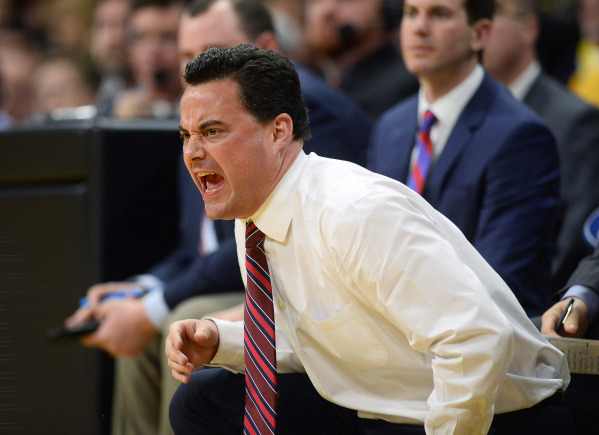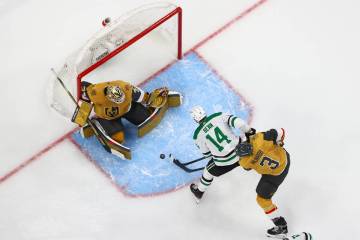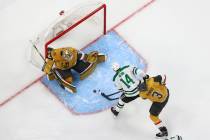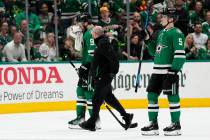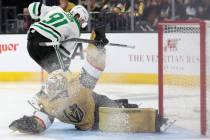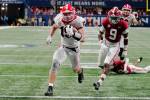Storming the basketball court could lead to major problems
First things first: There is no perfect way to ensure that everyone will be kept safe. Not the losing team and its coaches. Not even the winning team and its coaches.
And certainly not all those students and fans acting the part of crazies.
There is no perfect way unless the practice is outlawed and anyone who chooses to storm a basketball court after the final buzzer is threatened with arrest.
I'm not even sure that would deter most.
You might need one of those Donald Trump walls built inside every arena.
The Southeastern Conference could pay for them.
Just take the money from those recruiting envelopes.
I've struggled falling on one side of this issue more than most, because court storming defines the very fabric of exhilaration that college sports are intended to create. It has become as much part of the college experience as caffeine addictions and campus traditions.
Speaking of the latter, do kids at Stanford really need naked coeds handing out snacks at the library for motivation to study?
But the dangers of court storming are obvious at all levels, and while the number of documented serious injuries are few, isn't one enough to question whether the practice should be allowed?
Isn't it too much that a sports columnist in Iowa had his leg shattered during a court storm this season (no such luck, UNLV fans, my media seat has been moved to concourse level at the Thomas & Mack Center), that a Stanford-bound young man named Joe Kay was thrown to the floor and suffered a torn carotid artery and a stroke in 2004 after he made the winning dunk in a high school basketball game, leaving him paralyzed on the right side?
Sean Miller spoke out against court storming this week, and there hasn't been anyone nationally with more of a front-row view to its possible threats than the Arizona coach. In 10 of its past 11 road losses, the Wildcats have had opposing crowds storm the court, which says a lot about the program Miller has built and also how often his players have been caught up in such madness.
This was Miller after it happened Wednesday at Colorado:
"Eventually, what's going to happen in the Pac-12 is this: An Arizona player is going to punch a fan. And they're going to punch the fan out of self-defense. And when that happens, and only when it happens, will everybody take a deep breath and say, 'We have to do something to protect both teams.'
"Something has to be done. I'm going to be fine. Somebody can say whatever you want to me. Spit, do whatever you want. I'm worried about the players under my direction. We're almost at a point where guys have to protect themselves. And if they protect themselves, it's going to be a tough situation."
Uh-oh.
I understand Miller's concerns. It's dangerous. Things get insane, because, shock of shocks, those storming courts don't often prove to be the most sensible types.
But what Miller essentially did — besides his obvious ploy to get people talking more on the subject — was give his players approval to deck someone.
What if the player misses the intended fan he feels threatened by and hits another?
What if a child is seriously injured by mistake?
What if such a decision to engage incites a brawl much uglier than the one we saw with the Indiana Pacers and Detroit Pistons in an NBA game in 2004?
And there is this: Should an Arizona player, or one from any other team, choose to strike a fan, how much does that open the possibility of litigation against him and his coach and his university?
"As a lawyer, would I think it advisable to say what Sean Miler said?" said Justin Watkins of Battle Born Injury Lawyers. "No. No lawyer is going to co-sign to that. From a practical standpoint, I like it, because he obviously feels like his kids are in danger. He has a point, because players have the opportunity to protect themselves if they believe they are being threatened with physical violence.
"Now, if this happens, Sean Miller's (quotes) could be made into evidence, and he is going to be made a defendant, and you're going to argue he not only condoned it, he expressively authorized it and signed on to such behavior. As an attorney, if I'm representing the person who was decked, I would use (Miller's quotes) forever. I'm always bringing them up as evidence."
The SEC now fines member schools $50,000 for the first time fans storm a competition area, $100,000 for a second offense and $250,000 for a third. Many schools also have done a decent job forming a wall of security around teams and coaches when it becomes obvious a court could be stormed. There is always the idea that you could demand fans wait until teams depart the court before storming, but good luck with that when you consider the level of energy people have when planning to rush out.
There is no perfect answer, no full-proof deterrent, and the fact that ESPN and other media outlets continue to show court storms as part of a game's highlights certainly doesn't help diffuse the desire of kids to seek such attention.
I'm all for the college experience, and court storming has a place in creating such excitement. You just pray nothing serious happens each time fans pour from the stands, that nobody else has his leg shattered or a young man's life is altered forever.
It's amazing more people aren't injured during court storms.
I just hope Miller's words don't lead to something far worse than players needing help to exit a court.
That, and I would be absolutely stunned if those at Stanford (other than perhaps the band) ever storm anything.
Shouldn't they all be at the library getting snacks?
— Ed Graney can be reached at egraney@reviewjournal.com or 702-383-4618. He can be a heard on "Seat and Ed" on Fox Sports 1340 from 2 p.m. to 4 p.m. Monday through Friday. On Twitter: @edgraney




